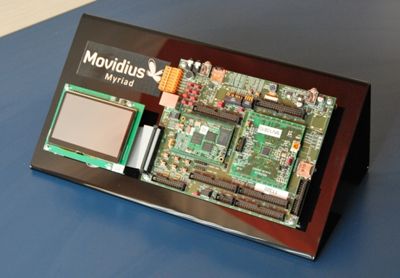From WikiChip
Difference between revisions of "movidius/myriad"
(→Myriad 1) |
(→Members) |
||
| Line 37: | Line 37: | ||
{{see also|movidius/microarchitectures/shave_v2.0|l1=SHAVE v2.0 Microarchitecture}} | {{see also|movidius/microarchitectures/shave_v2.0|l1=SHAVE v2.0 Microarchitecture}} | ||
[[File:Movidius Myriad Eval Board.jpg|thumb|right|400px|Myriad 1 Evaluation Board]] | [[File:Movidius Myriad Eval Board.jpg|thumb|right|400px|Myriad 1 Evaluation Board]] | ||
| − | The '''Myriad 1''' ('''MA11xx''') family of vision [[accelerators]] was introduced in [[2009]] and have undergone a number of enhancements along the way, each released under a new model and building on its predecessors. The Myriad 1 family is largely based on the {{movidius|SABRE}} test chip they've developed the prior year | + | The '''Myriad 1''' ('''MA11xx''') family of vision [[accelerators]] was introduced in [[2009]] and have undergone a number of enhancements along the way, each released under a new model and building on its predecessors. The Myriad 1 family is largely based on the {{movidius|SABRE}} test chip they've developed the prior year. All the models have the same basic features: |
* [[Nona-core]] processor | * [[Nona-core]] processor | ||
| Line 57: | Line 57: | ||
=== Myriad 2 === | === Myriad 2 === | ||
| + | This family first came to the public spotlight when they became the workhorse chips behind [[Google]]'s {{google|Project Tango}}. | ||
{{empty section}} | {{empty section}} | ||
Revision as of 22:21, 11 March 2018
| Myriad | |

| |
| Myriad 3D logo | |
| Developer | Movidius |
| Manufacturer | TSMC |
| Type | Neural Processors |
| Introduction | 2010 (announced) |
| Architecture | VLIW |
| µarch | SHAVE v2.0, SHAVE v3.0 |
| Process | 65 nm 0.065 μm , 28 nm6.5e-5 mm 0.028 μm , 16 nm2.8e-5 mm 0.016 μm
1.6e-5 mm |
| Technology | CMOS |
Myriad (also Myriad 3D Platform) is a family of ultra-low power hardware accelerators designed by Movidius specifically designed to accelerate vision processing.
Overview
| This section is empty; you can help add the missing info by editing this page. |
Members
Myriad 1
- See also: SHAVE v2.0 Microarchitecture
The Myriad 1 (MA11xx) family of vision accelerators was introduced in 2009 and have undergone a number of enhancements along the way, each released under a new model and building on its predecessors. The Myriad 1 family is largely based on the SABRE test chip they've developed the prior year. All the models have the same basic features:
- Nona-core processor
- Eight SHAVE v2.0 cores
- 1 SPARC LEON3 managing core
- 180 MHz
- TSMC's 65 nm process
- Up to 20 GFLOPS
- 1 MiB of shared memory (8x 128 KiB)
Models: (most of the differences are in the video capabilities of the chip)
- MA1100, advanced real-time video editing accelerator for smartphones
- MA1110, added support for 720p 30fps video recording and playback, real-time video editing, inline video, and 12-megapixel captures
- MA1133, video streams accelerator for auto-stereoscopic screens for smartphones
- MA1135, specifically for 3D converter box applications
Myriad 2
This family first came to the public spotlight when they became the workhorse chips behind Google's Project Tango.
| This section is empty; you can help add the missing info by editing this page. |
Documents
- Movidius Tokyo Seminar, December 2009.
- Movidius "Green Multicore" Keynote presentation, MCC 2011.
See Also
Facts about "Myriad - Intel Movidius"
| designer | Movidius + |
| first announced | 2010 + |
| full page name | movidius/myriad + |
| instance of | integrated circuit family + |
| main designer | Movidius + |
| manufacturer | TSMC + |
| microarchitecture | SHAVE v2.0 + and SHAVE v3.0 + |
| name | Myriad + |
| process | 65 nm (0.065 μm, 6.5e-5 mm) +, 28 nm (0.028 μm, 2.8e-5 mm) + and 16 nm (0.016 μm, 1.6e-5 mm) + |
| technology | CMOS + |
